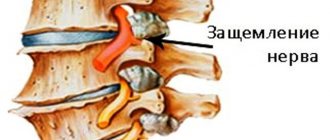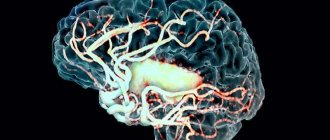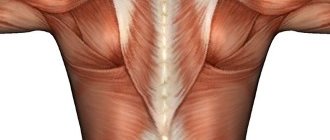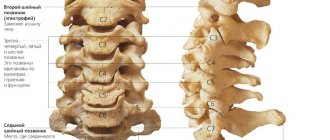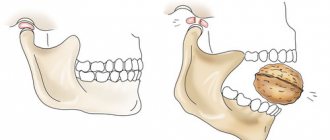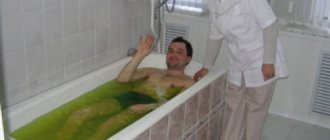The pain that occurs in the chest brings a lot of discomfort to a person. It interferes with full-fledged life activities and the performance of one’s duties. In some cases, it deprives a person of mobility - this often happens when the situation worsens and attacks become regular. In the vast majority of cases, the cause of such conditions is thoracic neuralgia . how to identify this pathology in yourself in the early stages of development, what to do to prevent its occurrence, what treatment methods and painkillers help with thoracic neuralgia .
Origin of the disease
There are many reasons that can provoke the appearance of intercostal neuralgia.
In most cases, neuralgia is associated with diseases of the spine. The most common finding is a hernia or protrusion. These diseases are associated with protrusion of the contents of the fibrous ring located in the intervertebral disc. Intervertebral hernias rarely occur in the thoracic region; the cervical and lumbar regions are more often affected. The frequency of lesions is directly related to the degree of load and mobility of the vertebrae. Pain with intercostal neuralgia tends to radiate from one area to another. An example is the transfer of pain from the lower back, where the hernia is located, to the thoracic spine. Intercostal neuralgia often appears against the background of osteochondrosis with pinched nerve roots.
Another common cause is injuries, fractures and sprains. If the patient has previously suffered a rib fracture, neuralgia can become a frequent companion of life. The consequences of fractures or sprains rarely go away without a trace, so you need to try as much as possible to protect yourself from such incidents in life, so that you don’t have to deal with the consequences later.
It is important to note that surviving a bullet or knife wound also predisposes to the appearance of thoracic neuralgia if a person was wounded in the middle region of the body. A complication in the form of a syndrome is associated with damage to nerve endings.
Sometimes an untreated infectious process occurs that can cause complications in the form of intercostal neuralgia. The name for infectious muscle inflammation is myositis. More often, pathology occurs against the background of a viral or bacterial infection. Less commonly, the infection is associated with a toxic, fungal or parasitic infection.
Forms of neuralgia
This disease comes in only two forms:
- Primary. Pain response of a specific nerve, unrelated to any specific stimuli. In most cases, it is never possible to identify its original source (discomfort can be caused by stress, the release of adrenaline into the blood, or the presence of certain diseases). This pathology can be cured with an integrated approach; treatment should be aimed at suppressing painful sensations. The most common type is triangular neuralgia;
- Secondary. It is provoked by third-party pathologies, for example, aneurysms, inflammation or tumors. Treatment of this form is more difficult; first of all, the patient will need to get rid of the original source, and only then from the painful sensations. Secondary neuralgia is very dangerous, since in about half of cases it is a symptom of more serious diseases.
The main causes of intercostal neuralgia
Most often the disease is associated with hernias, osteochondrosis, injuries or myositis. Also, tumor processes, muscle hypertonicity, poor circulation, persistent decrease in immunity, the herpes virus and the appearance of herpes zoster can lead to damage to nerve endings.
Provoking factors influencing the outcome of the disease also include:
- Previously suffered hypothermia.
- Severe physical and nervous stress.
- Alcohol abuse.
- Presence of diabetes mellitus.
- Severe deficiency of B vitamins.
- Other diseases that negatively affect the circulatory system and nerve endings.
It is important to take into account the person’s age and type of activity. In professional athletes, intercostal neuralgia of the chest is associated with injuries and muscle strain. In elderly people, the disease may be a consequence of polyradiculitis - inflammation of a plurality of nerve fibers, which occurs against the background of Alzheimer's disease, multiple sclerosis, brain tumors and chronic neurasthenia.
In women during menopause, the disease is often associated with hormonal changes. To remove signs of the disease, it is enough to prescribe HRT to correct the patient’s condition.
If intercostal neuralgia appears suddenly, you need to take into account the list of predisposing diseases, after which this phenomenon is often diagnosed:
- Herpes zoster.
- Aortic aneurysm.
- Heavy physical activity.
- Prolonged fasting leading to hypovitaminosis. It is especially important to stop the deficiency of B vitamins, magnesium and calcium in the body.
- The presence of ulcers and gastritis, due to which the absorption of vitamins and microelements is reduced.
With herpes zoster, there are signs of acute inflammation of the pancreas - pancreatitis. Since the herpes virus negatively affects nerve endings, causing ganglion pathologies, signs of neuralgia may appear over time. The initial symptom is the appearance of red blisters in the left hypochondrium, where the pancreas is approximately located. Since compression of blood vessels occurs when wearing tight underwear due to illness, intercostal neuralgia may occur.
Risk factors, causes
According to the ICD, intercostal neuralgia has code M79.2. It belongs to the category of “neuralgia and neuritis”; the malaise is often confused with a heart attack, because their symptoms are largely similar. It can occur after irritation and pinching of the nerves located between the ribs in the chest area, which is accompanied by severe pain.
Risk factors
Under certain circumstances, people may develop neuralgia for no obvious reason. This is caused by the presence of certain factors in life, and the more there are, the higher the likelihood of suffering from damage to the intercostal nerves.
Main risk factors:
- Hypothermia of the body;
- Disturbances in the functioning of blood vessels;
- Intoxication with harmful substances or alcohol;
- Lack of vitamin B;
- Metabolic failures;
- Poor nutrition;
- Mental stress.
Neuralgia most often occurs in adults and older people. A child can also suffer from such ailment, but this is quite rare.
Causes
The appearance of intercostal neuralgia is always caused by pinched or irritated nerves. This can occur with certain pathologies or disturbances in the normal functioning of the body. In some cases, several reasons are combined at once. Their identification is of great importance, because To get rid of neuralgia, it is important to treat the root cause.
The main reasons for the development of neuralgia:
- Viral or infectious diseases;
- Serious physical activity without preparation;
- Muscle spasms between the ribs;
- Hypertonicity of muscle tissue;
- Inflammation of the intercostal muscles;
- Cervical or thoracic osteochondrosis;
- Intervertebral hernia;
- Injuries and pathologies of the spine;
- Congenital chest defects;
- Development of neoplasms;
- Problems with the cardiovascular system;
- Kidney diseases;
- Poor circulation;
- Multiple sclerosis;
- Ulcer, gastritis;
- Tuberculosis;
- Diabetes;
- Excessive salt deposits in the body;
- Hormonal imbalances;
- Incorrect posture;
- Colds, decreased immunity.
Often the cause of neuralgia is pregnancy. Hormonal changes, the appearance of edema, increased stress on the body, compression of internal organs - all this leads to irritation and pinching of the nerves, causing intercostal neuralgia in a woman. It can also occur in newborns if carried incorrectly by adults. Moreover, any baby can suffer from neuralgia even with a slight draft or the slightest hypothermia.
Symptoms of the disease
The main symptom that occurs first is a sharp, paroxysmal pain in the chest or back. Discomfort occurs regardless of whether the patient is in a state of complete rest or active movement. Most often, shooting pains occur with a sudden change in body position, when the body turns or tilts. The pain intensifies during coughing attacks, after running and intense physical activity. One of the predisposing factors is rapid breathing. In this situation, pain is felt when palpating the intercostal areas of the chest.
The duration of pain is also not limited. Discomfort is felt from several minutes to several days with periods of intensification and subsidence. During the period of deterioration, signs of numbness of the torso are observed, which is associated with damage to the nerve endings. Many patients worry that the pain is related to the heart, but most often this is not the case. Relief occurs when you hold your breath and take a relaxed posture.
By what criteria can you distinguish heart pain from intercostal neuralgia:
- The nature of the discomfort during an attack of angina is strong, with a feeling of squeezing in the chest. With a neurological disorder - aching pain, dull and with lumbago.
- According to the accompanying symptoms, heart pain is accompanied by a feeling of lack of air, the patient’s skin turns pale. With neuralgia, there is sweating, pressure surges, and the pain increases with movement.
- With pain in the heart, the discomfort is localized closer to the left side of the chest, when, against the background of neuralgia, the pain has a vague and wandering character, often at the level of the intercostal spaces.
- Provoking factors: heart - physical and nervous tension, neuralgia - sudden turns.
- Taking medications: heart - relief when using nitroglycerin if an attack of angina occurs; neuralgia - weak relief of discomfort when prescribed anti-inflammatory drugs and muscle relaxants.
If the patient, in addition to signs of intercostal neuralgia, has red blisters on the skin, this indicates herpes zoster.
Complication
If a patient experiences complications due to intercostal neuralgia, they are quickly stopped at the stage of the appearance of the main symptoms. In advanced situations, when neuralgia has been bothering you for a long time, there is an increased risk of death of the disturbing nerve. At this stage, the pain stops, but shortness of breath and a feeling of heaviness in the chest appear.
If the patient is in a sitting position for a long time, the risk of spinal canal dysfunction increases, which will lead to osteochondrosis in the future. If treatment is started on time, complications do not arise.
Diagnosis of pathology
A neurologist helps determine the cause of pain. If similar symptoms appear, you should initially contact a cardiologist to rule out cardiac pathology during the examination. Various diagnostic methods are used, including cardiogram and ECHO. If there are no heart problems, the patient is referred to a neurologist. An experienced doctor pays attention to the patient’s posture - in case of pain due to neurology, the patient tries to find a comfortable position in order to minimize severe discomfort.
The doctor examines the patient, asks about complaints and makes a preliminary diagnosis. Instrumental diagnostics are necessary in order to exclude disorders of the internal organs, including the stomach, digestive tract and other diseases of the spine. More often, X-rays and MRIs are performed to determine the presence of osteochondrosis or hernia as a possible root cause of intercostal neuralgia. If such diagnoses are not confirmed, the above diagnosis is made, after which appropriate treatment is prescribed. It is also recommended to conduct a study of the respiratory system to exclude pathologies from the lungs.
Prevention
In order to reduce the likelihood of developing this disease, you need to lead a healthy lifestyle and monitor your diet.
Here are some tips doctors recommend you follow:
- It is necessary to exclude all “harmful” foods from the diet; it should be based on vegetables, fruits, fish and dairy products;
- you need to eat 5 times a day in small portions;
- to improve immunity, you can take a course of multivitamins twice a year;
- It is strongly recommended to follow a daily routine, go to bed and wake up at approximately the same time;
- At least three times a week you need to take walks in the fresh air and do exercises in the morning.
Any form of neuralgia is a serious test for a person. To protect yourself from possible complications, you should never self-medicate, because incorrectly selected medications can only worsen the situation.
Each patient must remember that only an experienced specialist can provide real assistance in the treatment of this pathology.
Treatment of intercostal thoracic neuralgia
For the most part, therapy is aimed at eliminating discomfort. This can be achieved with medication and conservative treatment. First aid measures for acute pain include the following algorithm of actions:
- The patient should remain in a comfortable bed for several days.
- It is necessary to purchase an orthopedic mattress and pillow so that the patient can rest properly. A hard and firm surface is recommended.
- If the bed is soft, a hard base is placed underneath. Otherwise, if the mattress is soft and springy, the patient's condition will deteriorate sharply.
- If the condition does not stabilize within a few days, medical attention will be required.
Drug therapy plays a major role in pain relief. To eliminate symptoms, you must use the following medications:
- NSAIDs. Recommended drugs are Meloxicam, Diclofenac and Nimesil. These drugs simultaneously exhibit a strong analgesic and anti-inflammatory effect. Non-steroidal anti-inflammatory drugs also affect the pain associated with problematic nerves, which is why they are effective in treatment. The attending physician must prescribe a course of treatment. Typically, the duration of use should not exceed 2-3 days.
- Muscle relaxants. These drugs relieve painful muscle spasms and also affect nerve conduction, relaxing inflamed nerves. In many cases, the affected area of muscle tissue, called the trigger, can cause neuralgia, but can be successfully treated with medication. Examples of products are Sirdalud, Mydocalm, Baclofen.
- Sedatives or tranquilizers. They have a depressant effect on the central nervous system, so they help the patient relax, relieving nervous tension. An example of medications is Adaptol, Persen, Novopassit.
- B vitamins. In modern medicine, neurotropic vitamins are very often prescribed, as they have a wide range of effects. Cyanocobalamin, thiamine and pyridoxine are used in neurological and general therapeutic practice to prevent the development of various ailments, including anemia, radicular syndrome, skin and hair lesions. Complex vitamins improve blood counts, metabolic processes and reduce pain sensitivity when a nerve is pinched. An example of trade names is Neurorubin, Milgamma.
Conservative treatment methods
A combined approach to therapy shows a particularly good result with frequent exacerbations. In addition to the use of medications, patients are prescribed physiotherapeutic procedures, after a course of treatment with which the patient also becomes better.
What treatment procedures do experts recommend:
- Massage. This type of influence helps with frequent manifestations of intercostal pain that occurs against the background of severe muscle spasm. Muscle relaxants do not always help in monotherapy, so advanced cases require a comprehensive solution. The massage therapist, using the contact pressure of his hands, independently squeezes the tight muscles and relaxes the triggers, after which the patient feels better. As a result, severe discomfort disappears and local blood circulation temporarily improves. It is recommended to visit a massage therapist several times a year, 5-10 sessions.
- Acupuncture. This is an ancient method that allows you to relax tight muscles through a reflex response to an irritant. During practice, specialists use special needles that touch pain points on the body. As a result, the triggers are unclenched and the patient’s signs of intercostal neuralgia or spasm of the vagus nerve disappear.
- Physiotherapy. Physiotherapy refers to the treatment methods of traditional medicine, which combine hardware effects with the use of medications. Medicines—vitamins or painkillers—are applied to a specific area of the body. Then radiation of a certain frequency is sent, with the help of which medicinal substances are absorbed transdermally - through the skin. Depending on medical indications, magnetic therapy and electrophoresis are prescribed. Shock wave therapy may be used less frequently if the patient has concomitant diseases.
- Manual therapy. This type of conservative treatment is rarely prescribed in the presence of signs of spasm of the vagus nerve, but the work of a chiropractor is effective in the presence of concomitant diseases of the spine - scoliosis, hernia, protrusion. The essence of the method is a contact effect on the affected areas of the spine, during which the specialist eliminates muscle imbalance and aligns the ridge.
Treatment with traditional methods
Since in most cases intercostal neuralgia is not a serious condition, in most cases the pain can be relieved with the help of improvised remedies based on home therapy methods.
The following methods usually help:
- To relieve severe pain, the affected area of the body should be coated with a mixture of equal proportions of freshly squeezed radish and horseradish juice. These vegetables contain locally irritating components that will temporarily eliminate discomfort.
- If the pain is sharp and sudden, a compress based on an alcoholic tincture of rue or a compress made from geranium tincture helps.
- You can rub homemade ointment based on aspen buds into the affected areas. The dried components are ground and mixed with petroleum jelly in a ratio of 1 to 4, where the majority are aspen buds. You need to apply the product 2-3 times a day until the symptoms disappear completely.
- It is useful to take restorative decoctions. Sage, orange peel, chamomile and lemon balm have good immunostimulating, antiseptic and anti-inflammatory properties. These dried components are mixed in equal proportions and infused in boiling water for 15-20 minutes. Then the broth is filtered and honey is added for taste. It is recommended to drink the tincture 2 times a day.
- Wormwood lotion will help remove unpleasant sensations. You need fresh wormwood, which is steamed with boiling water and then ground to a porridge. Then add a few drops of sea buckthorn essential oil to the mass and apply to the affected area.
- Baths with sage extract and sea salt help relax the nervous system, which relieves pain.
If, when using traditional methods, relief does not occur within 1-2 days, you must consult a doctor to prescribe the correct treatment.
Treatment tactics
It is also important to understand that the approach to correcting the problem requires a comprehensive approach. Only medications for intercostal neuralgia in the thoracic region are not able to correct the situation. Other manipulations will also be required. It can be:
- Exercise therapy. Gymnastics for thoracic neuralgia helps improve blood circulation and prevent the situation from getting worse. But, you need to understand that it should become part of your lifestyle, and not be performed periodically.
- Massage for thoracic neuralgia can be performed only at the stage of remission. It improves blood circulation and relaxes muscle tissue that is overly tense.
- At the stage of acute pain, doctors prescribe injections for thoracic neuralgia. They help to quickly relieve negative symptoms.
Next, we will consider in more detail which treatment tactics are most effective when a patient is diagnosed with thoracic neuralgia and whether it is possible to allow treatment at home .
First aid
Most often, unfortunately, patients consult a doctor when they are tormented by acute, paroxysmal pain. Therefore, the specialist’s main task is to relieve negative symptoms and return the person to a normal lifestyle. In this case, injections are prescribed, but only when the chest pain due to neuralgia becomes unbearable. These are so-called blockades, which deliver the medicine directly to the affected area. That is why the effect is felt in the shortest possible time. Injections for intercostal neuralgia in the thoracic area are most often prescribed with Novocaine.
Drug therapy
Any thoracic neuralgia and symptoms that appear in women and men require the following medications:
- Painkillers such as Analgina, Ketonal, Ketorol. It is important to remember that these medications help eliminate symptoms, but their long-term use can cause problems with the gastrointestinal tract.
- Also, when neuralgia in the thoracic region is diagnosed and the symptoms are quite pronounced, patients are prescribed medications from the non-steroidal group. They most often come in the form of a gel or ointment and are applied topically. Ketonal, Voltaren, Nise gel, Diclofenac have proven themselves well. The advantage of these drugs is that they have few side effects and virtually no contraindications.
- Vitamin and mineral preparations can be used as complex therapy. They allow you to saturate the body with the missing biochemical elements and restore normal functioning. But, at the same time, it is important to realize that the use may extend over time, since short-term use will not have the desired effect.
- Symptoms of thoracic neuralgia in women and men on the left and right can be eliminated with drugs based on poisons. True, they should not be used by pregnant and lactating women, those with elevated body temperature, those suffering from allergic reactions, as well as those who individually cannot tolerate the components of such compositions. Apizartron and Viprosal ointments have a pronounced effect.
- If a patient has a fever due to chest neuralgia, then he needs drugs from the group of non-steroidal anti-inflammatory drugs. These include Celecoxib, Meloxicam, Nabedolac, Ketoprofen, Diclofenac, Naproxen, Ibuprofen, Indomethacin. It is important to understand that it is better to choose drugs of a new generation, since they are devoid of ulcerogenic side effects, or rather, do not affect the mucous membrane of the gastrointestinal tract in the case of long-term course use.
Massage
The doctor may also prescribe a course of massage when neuralgia manifests symptoms and affects the thoracic region on the right side or the left region. In this case, the following pronounced effects are expected:
- The proper level of blood circulation is established, due to which nutrients are supplied in an enhanced manner to the affected area. Oxygen saturation also occurs.
- Overly tight muscle structures relax. As a result, nerve roots may be released.
- The inflammatory process is relieved and swelling is eliminated.
Due to this, the symptoms of intercostal neuralgia of the thoracic region in men and women gradually weaken and then disappear completely. But, to carry out a complex or segmental massage, the following rules must be taken into account:
- You can only act if there are no pronounced symptoms. That is, at the stage of remission. But in the acute phase of the disease, massage cannot be used.
- It must be carried out in a course of 10–15 procedures. You can repeat the procedure after a certain period of time.
- The manipulations must be performed by a high-level professional, since otherwise the opposite effect can be achieved.
- Under no circumstances should you prescribe a massage yourself, as this is a full-fledged physiotherapy procedure. It can only be recommended by the attending physician, based on the symptoms and severity of the disease.
- Remember that massage will have a positive effect only if the neuralgia of the chest in the middle or side of the body is subjected to a complex effect.
By the way, the person who will perform the massage must have a complete medical history. This way it will be easier for him to navigate what can and cannot be done in each specific case.
If intercostal neuralgia of the chest responds to the massage therapist’s actions with painful sensations, then the specialist must change the tactics of influence. The patient should not experience obvious discomfort. Therefore, during the manipulation, he must inform the massage therapist about his feelings.
Also, everyone should know that massage has a number of contraindications. Therefore, before prescribing it, the doctor must be informed about all existing chronic pathologies.
ethnoscience
Traditional recipes can be used when thoracic neuralgia and symptoms appear in men and women. But in no case should you rely only on these methods, since they can only be additional. Otherwise, you can start the disease and cause a serious condition.
The following recipes can be used to help in situations where thoracic neuralgia shows symptoms in women and men:
- Boil the egg hard and, while it is in this state, peel it and apply it to the sore spot. This ensures uniform and not too pronounced heating, which reduces the inflammatory process and improves blood circulation.
- You can also degrease the area of skin in the sore spot using alcohol. Then stick a pepper patch there.
- You can do the same with a horseradish leaf. The skin must also be degreased first, and then a whole leaf of the plant must be applied. Remember that horseradish quite effectively removes all salts from the body. Therefore, it can be used for various pathologies that are characterized by disruption of bone and cartilage structures, as well as the development of degenerative processes in them.
- You can use willow bark in an amount of 10 g in dry form. It must be filled with 250 ml of boiling water and brought to a boil. After this, the composition is cooled and filtered through a strainer or gauze. The resulting decoction is drunk in an amount of 15 ml (equal to 1 tablespoon) three times a day, spread as much as possible during the waking period.
Effective exercises
When a patient suffers from neuralgia on the left or right side of the chest , it is necessary to perform exercise therapy. Moderate and feasible physical activity in the form of specially selected gymnastics will help:
- Establish the blood circulation process.
- Strengthen the muscle frame and remove excess stress from the spine.
- Enrich damaged organs and tissues with oxygen and all necessary nutrients.
- Relieve muscle spasms.
Gymnastics for intercostal neuralgia of the thoracic region should become part of the patient’s life, since performing it periodically will not bring the desired effect. Remember that it is intended more to prevent the progression of pathology than to eliminate its consequences.
Most often, exercises for intercostal neuralgia of the thoracic region include the following set of exercises:
- Smooth sideways bends of the body are performed from a standing position with legs spaced shoulder-width apart. At the same time, it is also necessary to raise your arms to increase the load on the body and achieve maximum stretching of the muscle tissue.
- Squats are performed with complete control of posture. The depth of the squat is not important here - the main thing is to maintain the correct position of the body.
- Exercises with an expander and football. You need to sit on a fitball. Place the rubber band on your feet and grab the opposite end with one hand. The second palm rests on the thigh. Then, while inhaling, you need to lift the tape, smoothly stretching it with your hand. In this case, you need to feel the stretch in the side of the body. Then repeat the same thing, but with the other hand.
If the patient suffers from shortness of breath due to thoracic neuralgia , before performing physical activity, it is important to analyze the functioning of the cardiovascular system. If there are pathologies in the functioning of the heart, then exercise therapy should be completely different, and not the same as for pathologies of the musculoskeletal system.
Taking into account all these recommendations, you can detect a similar pathology in yourself in the early stages and take emergency measures to prevent its development and eliminate severe symptoms.

